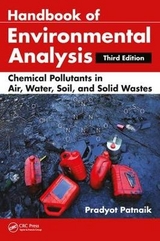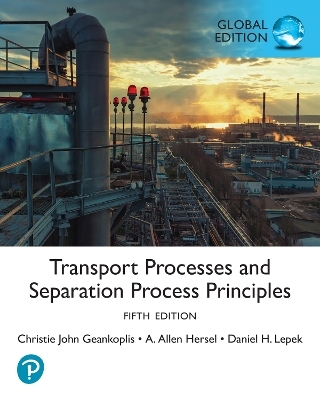
Handbook of Environmental Analysis
Crc Press Inc (Verlag)
978-1-4200-6581-7 (ISBN)
- Titel erscheint in neuer Auflage
- Artikel merken
A reflection of the myriad changes in the field of environmental analysis and the emergence of many new classes of pollutants in recent years, the second edition of Handbook of Environmental Analysis: Chemical Pollutants in Air, Water, Soil, and Solid Wastes covers all aspects of environmental analysis. Completely revised and updated to include new analytical techniques as well as additional chemical structures and reactions, this second edition retains the features — clarity of prose, pertinent examples, and authoritative coverage of a wide range of toxic pollutants — that made the first edition a bestseller.
New and updated information in the Second Edition:
Chapters on emerging pollutants such as pharmaceuticals, household products, nonionic surfactants, steroids, hormones, flame-retardants, and plasticizers
Chapters on oxyhalides, glyphosate herbicides, oil and grease, disinfection by-products, and haloacetic acids
A chapter on radioactivity
Updated NIOSH methods on air analysis
Revised content on gas chromatography and mass spectrometry
US EPA and Standard Methods
The book provides information on an array of topics from instrumentations, analytical techniques, and sample preparations to statistical calculations, chemical structures, and equations. It includes information on many alternative analytical procedures, making this edition more informative and versatile than its predecessor. It presents the tools and techniques required to measure a wide range of toxic pollutants in our environment.
Pradyot Patnaik is currently Laboratory Director of Environmental and Analytical Chemistry Laboratory of Interstate Environmental Commission at State Island, New York and is associated with the research program of Center for Environmental Science of City University of New York at the College of Staten Island.
Analytical Techniques
Introduction
Precision and Accuracy of Analysis
Analysis of Organic Pollutants by Gas Chromatography
Analysis of Organic Pollutants by Gas Chromatography/Mass
Extraction of Organic Pollutants and Sample Cleanup
Titrimetric Analysis
Colorimetric Analysis
Analysis of Metals by Atomic Absorption and Emission Spectroscopy
Ion-Selective Electrodes Analysis
Application of High-Performance Liquid Chromatography in Environmental Analysis
Ion Chromatography
Air Analysis
Application of Immunoassay Techniques in Environmental Analysis
Specific Classes of Substances and Aggregate Properties
Aldehydes and Ketones
Alkalinity
Bromide
Chloride
Cyanate
Cyanide, Total
Cyanide Amenable to Chlorination
Emerging Pollutants: Nonionic Surfactants—Alkylphenols and Their Ethoxylates
Emerging Pollutants: Organophosphate Flame Retardants, Plasticizers, and Lubricants
Emerging Pollutants: Pharmaceuticals and Personal Care Products
Emerging Pollutants: Steroids and Hormones
Fluorides|
Haloacetic Acids
Halogenated Hydrocarbons
Hardness
Herbicides: Chlorophenoxy Acid
Herbicides: Glyphosate
Hydrocarbons
Hydrocarbons, Polynuclear Aromatic
Nitrogen (Ammonia)
Nitrogen (Nitrate)
Nitrosamines
Oil and Grease
Oxygen Demand, Biochemical
Oxygen Demand, Chemical
Oxyhalides
Pesticides: Carbamate, Urea, and Triazine
Pesticides: Organochlorine
Pesticides: Organophosphorus
pH and Eh
Phenols
Phosphorus
Phthalate Esters
Polychlorinated Biphenyls
Polychlorinated Dioxins and Dibenzofurans
Radioactivity
Semivolatile Organic Compounds
Silica
Sulfate
Sulfide
Sulfite
Surfactant: Anionic
Thiocyanate
Volatile Organic Compounds
Selected Individual Compounds
Acetaldehyde
Acetone
Acetonitrile
Acrolein
Acrylonitrile
Aniline
Arsine
Asbestos
Benzene
Benzidine
Benzyl Chloride
1,3-Butadiene
Carbon Disulfide
Carbon Monoxide
Carbon Tetrachloride
Captan
Chloroacetic Acid
Chlorobenzene
Chloroform
2-Chlorophenol
Cumene
Cyanogen
Cyanuric Acid
Diazomethane
Diborane
Dichlorobenzene
1,1-Dichlorethylene
2,4-Dichlorophenol
Diethyl Ether
2,4-Dinitrotoluene
2,6-Dinitrotoluene
Epichlorohydrin
Ethylbenzene
Ethyl Chloride
Ethylene Chlorohydrin
Ethylene Dibromide
Ethylene Glycol
Ethylene Oxide
Formaldehyde
Freon 113
Hydrogen Cyanide
Hydroquinone
Hydrogen Sulfide
Isophorone
Methane
Methyl Bromide
Methyl Chloride
Methylene Chloride
Methyl Iodide
Methyl Isobutyl Ketone
Methyl Isocyanate
Methyl Methacrylate
Nitrobenzene
Nitrogen Dioxide
Pentachlorophenol
Phosgene
Pyridine
Pyrocatechol
Pyrogallol
Resorcinol
Stibine
Strychnine
Styrene
Sulfur Dioxide
Tetrachloroethylene
Tetraethyllead
Tetraethyl Pyrophosphate
Tetrahydrofuran
Toluene
Toluene-2,4-Diisocyanate
o-Toluidine
1,1,1-Trichloroethane
Trichloroethylene
2,4,6-Trichlorophenol
Vinyl Chloride
Xylene
Bibliography
Appendix A: Some Common QC Formulas and Statistics
etection Limits for Organic Pollutants in Aqueous Samples
Appendix B: Sample Containers, Preservations, and Holding Times
Appendix C: Preparation of Molar and Normal Solutions of Some Common Reagents
Appendix D: Total Dissolved Solids and Specifi c Conductance
Appendix E: Characteristic Masses of Miscellaneous Organic Pollutants
Appendix G: NIOSH Methods for Air Analysis
Appendix H: A Full List of NIOSH Analytical Methods for Indoor Air Analysis (Update 2006)
Appendix I: U.S. EPA Methods for Air Analysis
Appendix J: Inorganic Test Procedures for Analysis of Aqueous Samples: EPA, SM, and ASTM Reference Methods
Appendix K: U.S. EPA’S Analytical Methods for Organic Pollutants in Aqueous and Solid Matrices
Chemical Compounds Index
CAS Registry Index
Index
| Zusatzinfo | 331 Equations; 84 Tables, black and white; 94 Illustrations, black and white |
|---|---|
| Verlagsort | Bosa Roca |
| Sprache | englisch |
| Maße | 156 x 235 mm |
| Gewicht | 1262 g |
| Themenwelt | Technik ► Umwelttechnik / Biotechnologie |
| ISBN-10 | 1-4200-6581-5 / 1420065815 |
| ISBN-13 | 978-1-4200-6581-7 / 9781420065817 |
| Zustand | Neuware |
| Haben Sie eine Frage zum Produkt? |
aus dem Bereich



